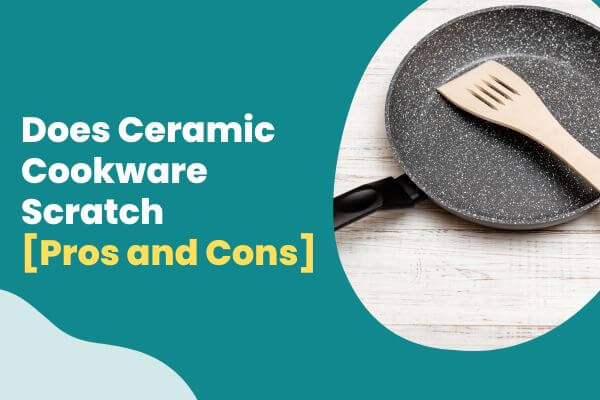As a passionate home cook, I’ve often pondered on the best cookware to use. Recently, my focus has been on ceramic cookware, particularly its durability and whether it can withstand the daily rigors of cooking without scratching.
I’ve done some digging, and it’s clear that ceramic cookware has pros and cons. It’s loved for its aesthetic appeal, non-stick properties, and ease of cleaning, yet, there are concerns about its susceptibility to scratches.
So, does ceramic cookware actually scratch? Is it safe to use a scratched ceramic pan? And if they get scratched, how can we fix or prevent them from scratching in the future? Also, are there better alternatives out there?
Let’s delve right into these questions, and hopefully, by the end of this article, you’ll have enough info to make an informed decision about your cookware.
Let’s get cooking!
Does Ceramic Cookware Scratch?
Sure, ceramic cookware can get scratched, but don’t worry. It’s much tougher than you might think! The ceramic coating is harder and more durable than other non-stick surfaces, like Teflon. So while it’s not entirely scratch-proof, it certainly stands up better to the rigors of everyday cooking.
However, it’s not invincible. If you use metal utensils or harsh cleaning materials, you can still damage the surface. So, my advice? Stick with wooden or silicone utensils and a soft cloth or sponge for cleaning.
And remember, even though it can be scratched, ceramic cookware is still a fantastic choice for those who value our culinary freedom. It’s tough, versatile, and gives us the control we need to create delicious meals.
Why Do Ceramic Pans Get Scratched?
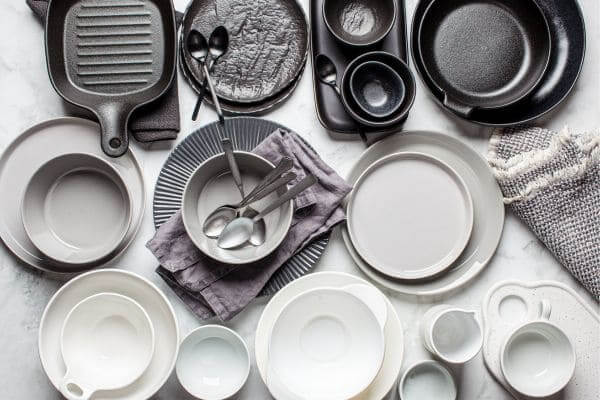
As someone who frequently uses ceramic pans, I’ve noticed that these pans can get scratched due to several factors.
For instance, using metal utensils can cause scratches, as can using abrasive cleaning materials that are too harsh for the pan’s surface.
Overheating the pan or accidentally dropping or banging it can also lead to scratches.
1. Using Metal Utensils
While you might be tempted to use your favorite metal spatula or spoon, it’s important to remember that these can cause scratches on your ceramic cookware.
We all love the feel of these sturdy tools, but there may be better choices than using metal utensils on ceramic surfaces. They’re sharp and hard, making them more likely to leave marks or cause damage.
It’s not about completely giving up on your beloved metal kitchen aids but about being conscious of their impact on your ceramic cookware. You’re free to make your own choices, but knowing the potential risks can help you make more informed decisions.
So, think twice before using that metal fork or knife next time you cook with ceramic.
2. Using Abrasive Cleaning Materials
Believe it or not, those abrasive cleaning materials you’ve been using could do more harm than good to your beloved ceramic pans. I’m talking about those steel wool or scouring pads you’ve used to scrub off stubborn food residues.
Even though they might seem effective, these abrasive cleaning materials can scratch the ceramic pans’ surface. And you know what scratches lead to? They can strip off the ceramic coating, essentially the non-stick layer. With it, your food will start sticking to the pan, making your cooking experience more enjoyable and smoother.
So, be mindful of the cleaning materials you use on your ceramic cookware. You don’t want to ruin them inadvertently, do you?
3. Overheating
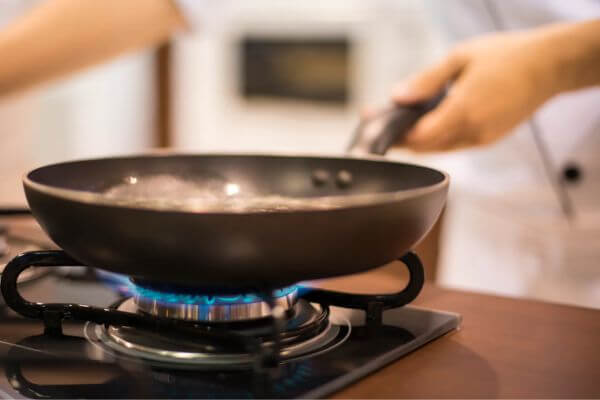
You might not realize it, but cranking up the heat on your ceramic pan can do more harm than good. It’s not just about a burnt meal; overheating can cause serious damage to the pan’s ceramic coating. The higher temperatures make the ceramic brittle, increasing its susceptibility to scratches.
This isn’t just a cosmetic issue; scratches can affect the pan’s performance.
Now, the pros of ceramic cookware are hard to ignore. It’s non-toxic, eco-friendly, and an excellent heat conductor. However, its vulnerability to heat is a major con.
It’s worth noting that not all ceramic pans are created equal. Some can handle higher heat, but the risk remains. So, monitor your heat levels closely to enjoy the freedom of healthy cooking with your ceramic cookware.
4. Dropping or Banging
Despite their numerous benefits, these non-toxic, eco-friendly pans aren’t invincible; a simple drop or bang can cause significant harm to the pan’s coating.
Dropping or banging ceramic cookware can lead to chips or cracks in its protective layer. This damage not only mars the aesthetic appeal but also diminishes the pan’s functionality. While the ceramic material is sturdy, it isn’t immune to the impact of a fall or a hard hit.
This vulnerability can be seen as a drawback. However, it’s essential to remember that all cookware requires a certain level of care. The freedom to use your kitchenware without worry comes with the responsibility of handling it properly.
So, even as you enjoy the benefits of ceramic cookware, be mindful of potential damage from dropping or banging.
Is It Safe to Use a Scratched Ceramic Pan?
As we dive into whether using a scratched ceramic pan is safe, it’s important to bear in mind a couple of key points.
First, the pan may not retain its non-stick properties as effectively as once, potentially leading to food sticking and burning more easily.
Secondly, a scratched pan could be more susceptible to warping, altering its shape and potentially impacting its cooking performance.
1. The Pan May Not Be as Non-Stick as It Once Was
Over time, your ceramic cookware might lose its non-stick properties, making it a hassle in the kitchen. While my Cosmo pan was great when I first got it, the scratches have taken their toll. Food sticks more often now, and cleaning it is more of a chore.
This is one of the cons of ceramic pans. They might start fantastic, but the durability just needs to be there. When food sticks, there’s a higher chance of it burning, which ruins meals and can damage the pan further.
While I enjoy the freedom of cooking with ceramic pans like my Cosmo pan, the potential for scratches and subsequent issues is something to consider.
Sadly, once those pesky scratches sink in, your beloved pan could start to warp, throwing off your cooking game and potentially putting it at risk of breaking. This warping isn’t just a superficial issue; it may impact how your pan heats and cooks food.
The uneven surface could lead to inconsistent cooking results, a major setback for any passionate cook.
Moreover, using certain utensils can worsen the damage. Metal utensils, for instance, can cause further scratches and deepen the existing ones. Therefore, being mindful of the utensils you use with your ceramic cookware is crucial.
While ceramic cookware offers many benefits, it must be carefully handled to maintain its integrity and prolong its life.
How to Fix Scratched Ceramic Cookware
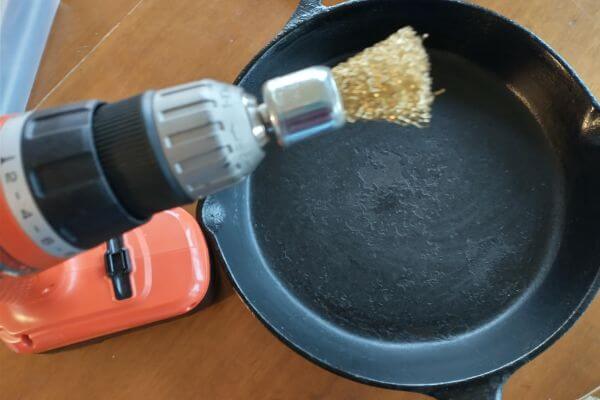
In today’s discussion, we will delve into ways you can fix scratched ceramic cookware, a common problem many of us face in our daily kitchen routines.
We’ll explore several methods, including using a ceramic scratch repair kit, a homemade baking soda paste, applying a diamond paste, and finally, replacing the pan.
It’s important to realize that these techniques can help prolong the life of your cookware and keep your food safe from potential contaminants.
Step 1. Use a Ceramic Scratch Repair Kit
You’ll find a ceramic scratch repair kit handy when dealing with pesky scratches on your cookware. These kits are specifically designed to restore the non-stick coating of your pans, offering a new lease on life for your favorite cooking surfaces.
The kit includes a special product that fills in the scratches on the ceramic surface, making it smooth and non-stick once again. To use it, all you need to do is thoroughly clean the pan, apply the product to the scratched areas, and then bake the pan in the oven as per the instructions on the package.
It’s a simple and cost-effective solution, allowing you to repair and maintain your cookware at home. So, don’t let scratches bother you. Just grab a ceramic scratch repair kit.
Step 2. Use a Baking Soda Paste
Should your favorite pan bear the marks of frequent use, fear not. A simple blend of baking soda and water can transform into a potent paste, gently buffing away those unsightly blemishes without causing further harm.
With this method, you can restore the sheen of your ceramic cookware, giving it a renewed life on your kitchen stovetop.
The use of baking soda paste for ceramic cookware scratches is a testament to the versatility of everyday materials. It’s cost-effective and environmentally friendly, a significant plus for those who desire freedom from harmful chemicals.
Furthermore, applying the paste and letting it sit for about 30 minutes is straightforward, making it a convenient option for busy households. Afterward, a simple rinse with warm water and pat dry with a soft towel will suffice.
Step 3. Use a Diamond Paste
Feeling desperate about those stubborn scratches on your favorite pan? Don’t give up yet; a heavy-duty solution might just work – enter the diamond paste method.
This is a more aggressive way to tackle those unsightly marks, but it has merits. First off, you’ll need a polishing machine and, of course, the diamond paste. You apply the paste directly to the scratches and then polish the pan until all the scratches disappear. It’s a bit more labor-intensive, but the results can be astounding.
However, always consider safety. Make sure to wear protective gear while using the polishing machine. And remember, this method should be your last resort in maintaining the beauty of your ceramic cookware.
Step 4. Replace the Pan
So, after trying the diamond paste method, you might find that the scratches on your ceramic cookware are too deep to repair. This brings us to our next option – replacing the pan.
It’s a tough call, but sometimes it’s the only way to ensure you cook on a safe, efficient surface. When the ceramic coating is damaged, it can compromise the non-stick feature of the pan and potentially release harmful particles into your food. Having reliable, safe tools crucial to your freedom in cooking.
So, while it may seem costly to replace the pan, consider it a necessary investment in your culinary freedom. After all, your health and food quality shouldn’t be compromised by damaged cookware.
How To Care For Your Ceramic Cookware
When caring for your ceramic cookware, there are a few key steps. Firstly, always use wood, plastic, or silicone utensils to avoid scratching the surface.
Secondly, gently clean your cookware using a soft sponge and mild dish soap, then rinse thoroughly to remove all soap residue. Drying your cookware immediately after washing is crucial to prevent water spots and rusting.
Lastly, avoid overheating your cookware, which can cause damage and decrease lifespan.
1. Use Wooden, Plastic, or Silicone Utensils.
You’ll find your heart skips a beat when you see the pristine condition of your ceramic cookware, all thanks to the gentle touch of wooden, plastic, or silicone utensils. These materials are softer and less likely to scratch the surface of your pots and pans. It’s not just about maintaining the look of your cookware but also about preserving its functionality.
Scratches can lead to chips in the ceramic coating, which can end up in your food and potentially be harmful. It’s crucial to remember that metal utensils are a no-go with ceramic cookware. They’re too harsh and can easily damage the surface.
So, investing in a set of wooden, plastic, or silicone utensils is a smart move. Besides, they add a touch of style to your kitchen and give you the freedom to cook without worry.
2. Wash Your Cookware with A Soft Sponge and Mild Dish Soap
After a delightful cooking session, gently cleanse your pots and pans with a soft sponge and a dab of mild dish soap to keep them in top-notch condition. It’s crucial to avoid harsh cleaners or abrasive scrubbing tools like steel wool or scouring pads. These can scratch and damage the ceramic coating, diminishing its non-stick properties and longevity.
Instead, opt for tools that are kind to your cookware. A soft sponge or cloth is your best bet for cleaning without causing harm. It’s not about being overly cautious. It’s about preserving your investment and enjoying the freedom that comes with cookware that performs at its best.
Remember, how you care for your pots and pans can directly impact their lifespan and functionality. So, treat them gently, and they’ll serve you well.
3. Rinse Your Cookware Thoroughly After Washing
Ensure you thoroughly rinse your pots and pans after washing them.
You see, any residual soap can leave a thin film on the surface of your cookware. This filmy layer can become a problem when you start cooking, as it can cause your food to stick to the pan.
I’ve learned that it’s not just about ensuring your pans are clean but also properly rinsed. This is especially important for ceramic cookware, as its smooth, non-stick surface can be compromised by soap residue.
So, after washing, I always pay extra attention to rinsing and removing all soap. It might seem small, but it’s a detail that can make a big difference in your cooking experience. Trust me; Your ceramic cookware will thank you.
4. Dry Your Cookware Immediately After Washing
Once I’ve rinsed my cookware thoroughly, I don’t stop there. I make it a point to dry it immediately after washing it. Here’s why.
When ceramic cookware is left wet, it can be more prone to scratching, a drawback that can potentially harm its quality and longevity. That’s why I immediately grab a soft towel and dry my ceramic pieces. This simple step doesn’t just keep my cookware looking good. It also extends its life by preventing unwanted scratches. It’s about preserving the freedom to enjoy my cookware for a long time without worrying about damage.
So, the next time you wash your ceramic cookware, remember to dry it immediately. It’s a small step with big benefits.
5. Refrain from Overheating Your Cookware
Avoiding high heat is another essential step in preserving your pans’ integrity, as overheating can damage the protective coating. It’s all about finding the right balance.
Cranking up the heat on your ceramic cookware isn’t necessary, and it can lead to some serious damage. Instead, opt for medium or low heat, which protects your pan’s surface and ensures that your food cooks evenly.
Overheating can cause the ceramic to crack, warp, or even lose its non-stick properties. It’s crucial to remember that ceramic cookware is designed for slower, more controlled cooking. So, take your time crushing up the heat. Your patience will pay off with deliciously cooked meals and a longer-lasting pan.
Embrace your culinary freedom, and remember to take it slow.
6. Avoid Using Your Cookware on Induction Cooktops
Remember, your beloved pans might not be the best friends with induction cooktops; the high heat can seriously threaten the integrity of their protective coating. It’s not just about the immediate damage, like charring or warping, but what it means in the long run.
The ceramic coating might start to crack and peel away, leaving your cookware vulnerable and less effective. And it’s not just about the meal you’re currently cooking. Damaging your cookware can affect the quality of your future meals too.
So, don’t let the allure of quick heating fool you. Keep those ceramic pans off the induction cooktop. It’s about preserving your freedom to cook delicious meals without worrying about damaging your tools.
7. Store Your Cookware Properly
Just as you wouldn’t toss your favorite dress or suit into a crammed closet, you shouldn’t stow your pans and pots haphazardly. Your ceramic cookware deserves a proper storage place to maintain its pristine condition.
It’s crucial to avoid storing them where they might get banged or scratched. It’s about more than aesthetics – scratches can diminish the non-stick properties of ceramic cookware, making them less efficient.
And only stack them with protection. If you must, use a soft cloth or pan protector between each piece to prevent scratches. Ideally, hang them up – it’s not just a stylish kitchen feature but a practical one too.
Proper storage isn’t a tedious chore but a way to ensure your cookware’s longevity. It’s worth the effort.
Alternatives to Ceramic Cookware that Are Less Likely to Scratch
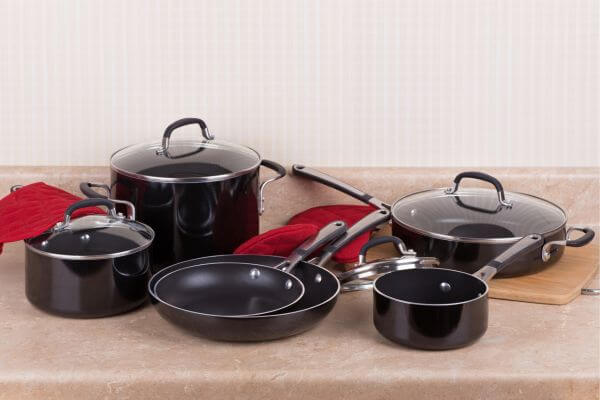
If you’re worried about your ceramic cookware scratching, plenty of durable alternatives exist. These include stainless steel, renowned for its durability and heat distribution. Cast iron is famed for its heat retention and non-stick properties when seasoned. Carbon steel combines the best of both. Remember copper, known for its rapid heating and cooling. Anodized aluminum is scratch-resistant and heats evenly.
1. Stainless steel
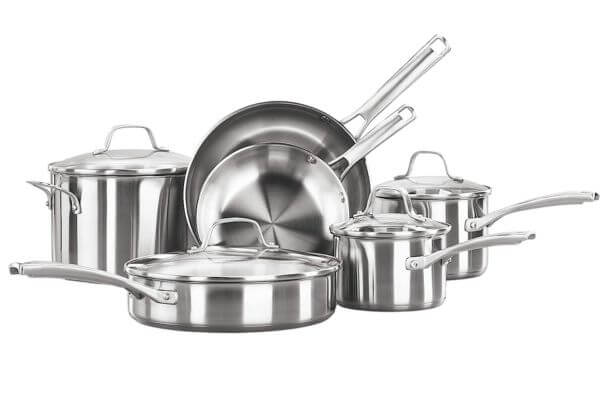
You’ll appreciate stainless steel’s remarkable durability and excellent heat conductivity, making it a top choice for cooking without worrying about those pesky scratches. Unlike ceramic, stainless steel isn’t prone to chipping or scratching, guaranteeing you a worry-free cooking experience. It’s a robust material that can withstand high heat and rigorous scrubbing, offering freedom in culinary adventures.
Moreover, its heat conductivity is top-notch. It ensures even heating across the cookware, reducing the chances of hotspots that can ruin your food. However, it’s not all rosy. Stainless steel can be a tad too efficient in conducting heat, leading to overcooking if you’re not careful. Additionally, it lacks non-stick quality, so you’ll need a bit of oil or butter to prevent your food from sticking. Nonetheless, its pros far outweigh the cons.
2. Cast iron
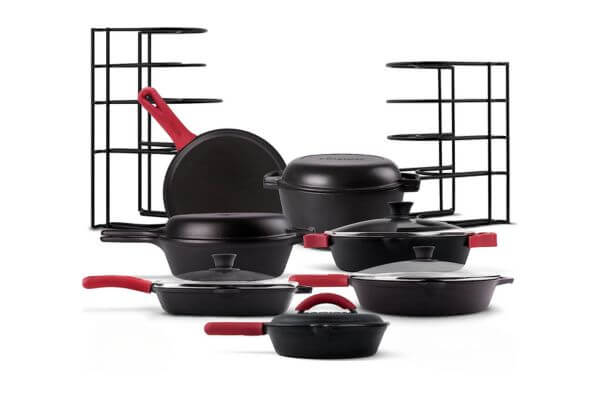
Like stainless steel, cast iron is incredibly durable and perfect for kitchen adventures. Unlike some other materials, it’s not easily scratched, so I can get a lot of use out without worrying about damaging it.
Cast iron is also a great heat conductor. This allows me to cook at high temperatures, which is ideal for searing meat or preparing other dishes that require intense heat.
One of the best things about cast iron is that it can withstand the test of time. It’s a material that’s meant to last. However, it does require proper care to prevent rusting, which can be a bit of a hassle. But the pros of using cast iron far outweigh the cons.
3. Carbon steel
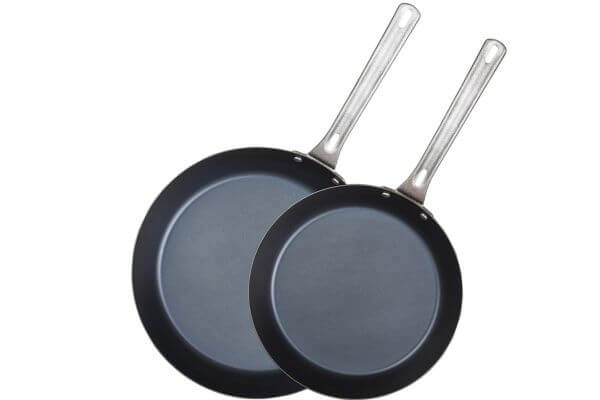
After experiencing the wonders of cast iron, you might think it can’t get any better, but wait till you discover the magic of carbon steel! This type of steel isn’t only lighter than cast iron, but it’s also more heat-responsive.
Imagine the freedom of effortlessly moving your pan around the stovetop while still enjoying cast iron’s heat retention and distribution. And yes, carbon steel can handle high heat, making it perfect for those sizzling stir-fries or searing steaks. But there’s a catch.
Its surface can scratch, especially if you need to be more careful with your cooking utensils. While it’s a great conductor of heat, you’ll need extra care to prevent damage.
So, is it worth it? That’s for you to decide, my freedom-loving friend!
4. Copper
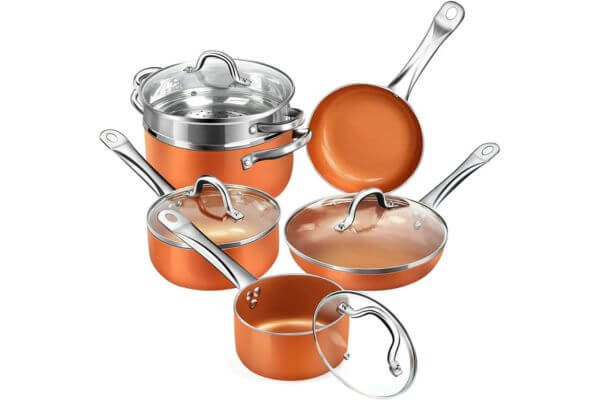
Just think of the copper pan as your secret weapon in the kitchen – it’s superconductive, meaning it heats up in a flash and spreads that warmth evenly.
However, remember that with great power comes great responsibility. Copper is more prone to scratching than other materials, so handling it with care is essential.
Despite this, it’s an excellent choice for searing meat or cooking high-heat dishes. But don’t fret; every rose has its thorn.
While copper may require more mindfulness, its benefits far outweigh its drawbacks. It’s a trade-off, true, but one that’s well worth it when you’re going for precision and power in your cooking.
So take the plunge and embrace the copper pan; it’s a kitchen game-changer.
5. Anodized Aluminum
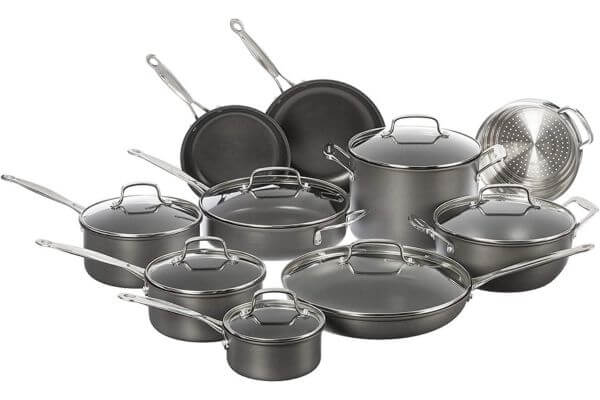
After discussing the unique attributes of copper cookware, let’s shift our focus to anodized aluminum. This particular type of aluminum is an excellent choice for those who value durability and functionality.
Why, you ask? Well, anodized aluminum undergoes a special process that significantly enhances its sturdiness, making it highly resistant to scratches. This means no more worrying about damaging your cookware while whipping up your favorite meals! It’s also an exceptional conductor of heat, ensuring even cooking and reducing the risk of those annoying burnt spots.
However, it’s not all sunshine and roses. Anodized aluminum tends to be pricier than other options, so it’s not the best fit if you’re budget-conscious. Yet, in the long run, the investment can be quite worthwhile.
Conclusion
In conclusion, I’ve found that ceramic cookware can scratch, but it’s safe to use and easy to fix. It’s important to take care of them properly to avoid damage. If you’re worried about scratches, there are alternatives to consider.
Always remember the right care and maintenance can extend the life of your cookware, regardless of the material.
Also, Check:

